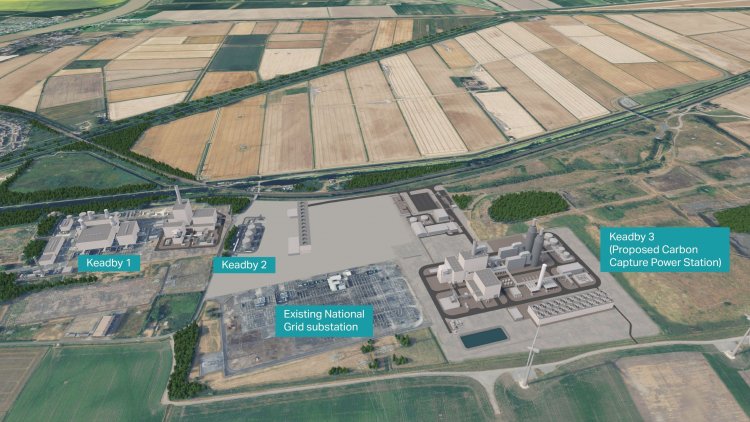Last December, UK utility SSE Thermal and Norwegian multinational Equinor announced that their proposed Keadby 3 project in North Lincolnshire, which consists of gas-fired power plant capable of generating up to 910 MW, equipped with carbon capture and storage (CCS) technology, had become the first project of its kind to be granted planning consent from the UK government. For SSE Thermal, it marked a major step towards its planned delivery of a series of low-carbon projects, part of its drive to help create a net-zero power system in the UK by 2035, Katy Burke, engineer manager, Keadby Carbon Capture Project, tells Gas Matters.
Shaking off coal
Based in Perth in central Scotland, Burke joined SSE 15 years ago as part of its graduate training programme. Starting out in process engineering with a focus on the company’s thermal fleet, over time she migrated to project engineering, a space she has been involved in for nearly seven years.
“I’ve had access to a range of projects, including spending time in our renewables business, but I’m now firmly in the thermal side of things,” says Burke. Looking back, her time at SSE has coincided with a period of dramatic change, not only for the UK’s energy landscape, but also for the company’s profile.
“At the start of my career, coal had the biggest share of the UK power market,” she recalls. “SSE had three major coal power stations, though by then they had lived their lives. Ferrybridge, for example, began operations in the mid-1960s and came off the bars in the mid-2010s – some 50 years of life. These assets played a massive part in the energy market in our country, but the time for them to go had come. The costs for emission abatement technologies were becoming too high, and we can’t carry on burning coal forever.”
When Burke first joined SSE, the company’s renewable business was still very small, consisting of just two onshore wind farms. Today it owns nearly 2 GW of operational onshore wind capacity in the UK and Ireland, with over 1 GW under development, while its offshore wind portfolio consists of two joint venture sites, Beatrice (588 MW) and Greater Gabbard (504 MW). Its offshore wind development pipeline is, at over 6 GW, the largest in the British Isles.
“We’re now leading the way in the offshore development space. Dogger Bank and Greater Gabbard are just enormous. Seagreen, off the coast of Angus, is another jewel in our crown, and we’re looking at developments in the Republic of Ireland. This shift to renewables is a huge amount of change in a short period of time. In a way, it takes SSE back to its roots – all the way back to the first hydro stations that were developed in Scotland. Parts of the Tummel Valley hydro scheme and some of our smaller hydro sites predate the Second World War and are still in operation. We’re the custodians of these historical assets, and I was fortunate to work on the replacement of the 90-year-old water turbines at Tummel.”
CCS juggernaut
A highlight of Burke’s career at SSE so far has been her involvement in Keadby 2, a new combined-cycle gas turbine (CCGT) plant in North Lincolnshire that is “the most efficient gas-fired power station in Europe”. SSE Thermal developed Keadby 2 together with Siemens Energy, and Burke was part of the team that took the project to financial investment decision. Another highlight is her current involvement in what she describes as “the juggernaut that is Keadby 3.”
Having been granted planning consent in December, the next steps for Keadby 3 include the UK government’s CCS cluster sequencing process, which will give the project the opportunity to receive a long-term contract. This would allow SSE Thermal and Equinor to deploy carbon capture technologies and connect to shared CO2 pipelines being developed as part of the East Coast Cluster (ECC) proposal in England, which includes Keadby 3.
CCS in the UK has been a rollercoaster of highs and lows. The environment has again become much more positive for CCS.
“The UK government’s cluster sequencing process kicked off in 2021 with the invitation for cluster submissions,” Burke explains. “We supported the ECC, as well as the Scottish Cluster. Others involved included HyNet in the north west of England and north Wales. ECC and HyNet were given Track 1 status, facilitating the power projects to make their submissions to the government, while the Scottish cluster was named as a reserve cluster.”
The Keadby 3 submission was put forward in January 2022 and was taken forward later that year alongside two other competing projects. “We’ve got one final hurdle to overcome, which is the final government selection process this year,” Burke says. “It will form the basis for the subsidy process that we’re going through with the government. There is still a down selection to go through. We’re waiting for more information on that, and what the process will be afterwards.”
Subject to reaching a final investment decision (FID) next year, Keadby 3 could be operational as early as 2027, and would capture up to 1.5 mt of CO2 per year, representing at least 5% of the UK government’s 2030 target. Emissions would be stored under the southern North Sea.
According to Burke, CCS in the UK has “been a rollercoaster of highs and lows.” Over the years, “SSE has themselves attempted to deploy CCS projects previously, with the most recent project being at Peterhead.” Though the UK government decided to stop the competition process it was running at the time for CCS, there has recently been “a shift again in mood, in the UK and globally,” she adds.
“The high profile climate conferences – for example, COP26 in Glasgow and, more recently, COP27 – in which the UK was heavily involved in, have played a role in this. Developers have tapped into this momentum, stressing that CCS is a national priority, and with increased focus on net-zero targets, this is driving project development forward. The presence of a mixture of power projects and industrial emitters in one concentrated area, for example in the East Coast Cluster, really facilitates this development and drives it forward. Everybody understands what we’re trying to do and why. The environment has become much more positive for CCS.”
Increased collaboration
As a large, industrialised part of eastern England, the Humber represents an ideal deployment opportunity for the low-carbon projects being developed by SSE Thermal and its partners, says Burke.
“It’s home to a lot of industry, including the steelworks at Scunthorpe. You also have the Drax power station. The Humber is the biggest emitter of carbon among the UK’s industrial regions, so it makes sense to target our decarbonisation efforts there, while prioritising these efforts on one area offers real focus.”
CCS technology is that bit further ahead than hydrogen, but hydrogen will eventually play a massive part in the decarbonisation picture.
SSE Thermal and Equinor are also collaborating on turning their existing Aldbrough gas storage site on the East Yorkshire coast into a low-carbon hydrogen storage facility. In June, the two companies agreed to buy Triton Power Holdings, which operates the 1.2 GW Saltend CCGT plant in the East Riding of Yorkshire – a potential offtaker to Equinor’s Hydrogen to Humber (H2H) Saltend hydrogen production project. The aim is to convert Saltend to burn a 30% blend of blue hydrogen by 2027, while SSE Thermal has previously also said it is “developing options” for blending natural gas with hydrogen at Keadby 2.
“Hydrogen is key on our development pathway,” comments Burke. “It’s all about technology development and deployment and looking at long-term goals. But I do think that, at the moment, CCS technology is that bit further ahead than hydrogen. Also, thanks to their testing facility for CO2 capture at Mongstad, Equinor has provided a wealth of knowledge that inform the carbon capture designs that we’re using. Hydrogen has to follow the same route, but is slightly behind CCS on the curve. However, it will eventually play a massive part in the decarbonisation picture.”
In the meantime, Burke believes that for the energy transition to succeed, creating synergies and encouraging knowledge sharing between companies is key. “We’re shifting towards a much more collaborative approach, partnering up with other industry stakeholders,” she says. “For example, our partnership with Equinor gives us insight in the CCS sphere. For their part, they pick up knowledge from SSE for the power generation aspect. We enjoy working with our Equinor colleagues.. As a result, the consortium that we’re working with on Keadby Carbon Capture includes Aker Solutions, Siemens Energy and Altrad Babcock. Each company brings its own area of expertise.”
As low-carbon projects increase in scale and move at a quicker pace, “it is only natural that more and more partnerships will develop,” Burke says. “The lines between different industries are getting blurred, and it’s becoming very difficult for one party to take on responsibility on their own when handling such big projects.”
Renewable storage
Meanwhile, the recent high costs of energy have underscored the importance of homegrown energy, as well as the need for a flexible generation mix – something that demands creative thinking, Burke stresses.
“How to prevent huge volatile swings in prices is certainly at the forefront of our mind. Self-sufficiency is quite apparent when developing our offshore wind capability, but when the sun doesn’t shine and the wind doesn’t blow, thermal really has to step in. This is why we need to develop more power stations equipped with CCS, as well as support our gas supply system through gas storage.”
The energy transition timescales are very aggressive, and rightly so. We’re getting to the point of no return with global warming.
At the same time, with projections showing that demand for power in Europe will rise considerably in coming year because of the transition of heating and vehicles to electricity, just as demand for gas is forecast to fall due to climate goals, the need to store excess renewable energy will become more pronounced, Burke adds.
“Storage will be key to this,” says Burke. “It’s all about maximising, particularly when the wind is blowing – trying to capture as much as you possibly can. For example, SSE is developing its Coire Glas pump storage scheme – but it’s important to understand the financial business case for such big storage schemes. Simultaneously, small-scale solutions can add up and play a massive part. More can be done with electric vehicle batteries.”
But for more investment to be made in storage for renewables, there needs to be a better understanding of what the future demand for power will look like, Burke points out: “It’s a matter of balancing the requirements of the users with what’s available to us at the lowest possible cost.”
Looking ahead, Burke would ideally like to see a future energy mix that consists of abated thermal generation, renewables and, eventually, hydrogen.
“It seems sensible to have a staged transition – as much as we can. The timescales are very aggressive, and rightly so. We’re getting to the point of no return with global warming. I think the energy transition has the right amount of urgency, but from a practical point of view, mobilising such large projects, which involve a great number of people, is already creating a pinch point in the labour market. Power generation projects are competing for talent with big, non-energy infrastructure projects nationally. We need to be mindful of not overstretching our supply chains.” To tackle the challenge of attracting people with the skills needed to support the energy transition, SSE does “a lot of outreach to schools and universities, getting people into technical jobs,” says Burke.
Ultimately, a phased approach is likely to lead from “what we can do now, which is CCS in power,” to a more prominent role for hydrogen, she predicts.
“I think the hydrogen economy will be huge, though there’s still a lot to think about in terms of production and distribution, not to mention safety. As we develop CCS, the hydrogen technologies are bound to follow. Storage will develop too, as we start to understand more of what the actual electricity demand is going to be in the future and how these storage projects fit in all this. There’s still a little bit of uncertainty, but hopefully it will soon clear up.” - KT
Header and main body images: Digital visualisation of Keadby 3 project. Credit: Aker Solutions, Doosan Babcock, Siemens Energy and Aker Carbon Capture
Subscription Benefits
Our three titles – LNG Business Review, Gas Matters and Gas Matters Today – tackle the biggest questions on global developments and major industry trends through a mixture of news, profiles and analysis.
LNG Business Review
LNG Business Review seeks to discover new truths about today’s LNG industry. It strives to widen market players’ scope of reference by actively engaging with events, offering new perspectives while challenging existing ones, and never shying away from being a platform for debate.
Gas Matters
Gas Matters digs deep into the stories of today, keeping the challenges of tomorrow in its sights. Weekly features and interviews, informed by unrivalled in-house expertise, offer a fresh perspective on events as well as thoughtful, intelligent analysis that dares to challenge the status quo.
Gas Matters Today
Gas Matters Today cuts through the bluster of online news and views to offer trustworthy, informed perspectives on major events shaping the gas and LNG industries. This daily news service provides unparalleled insight by drawing on the collective knowledge of in-house reporters, specialist contributors and extensive archive to go beyond the headlines, making it essential reading for gas industry professionals.






